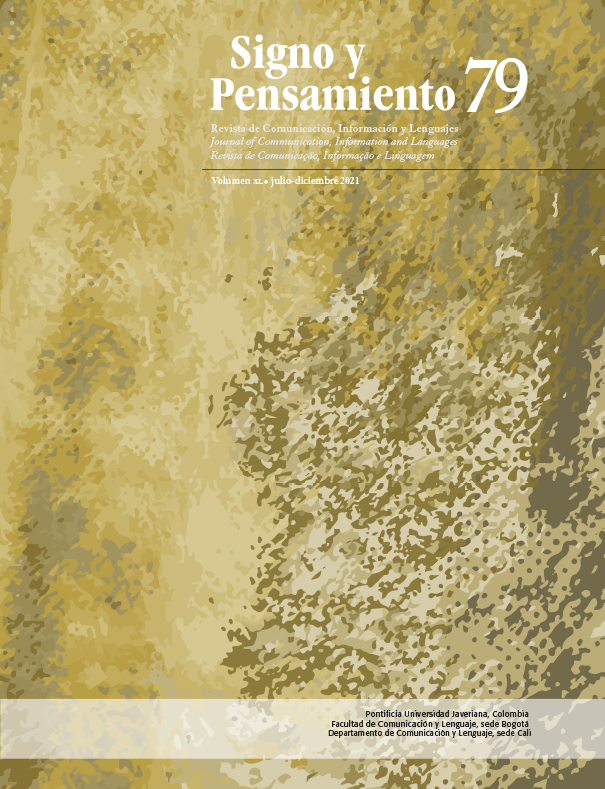Resumen
En este artículo, a partir de ejercicios cartográficos, más un análisis comparado y un análisis de contenido, establecimos un canon del wéstern cinematográfico que confrontamos con producciones propias del género en Sudamérica. Hemos encontrado que los realizadores de la región hicieron traducciones estilísticas y narrativas adaptadas a los entornos geográficos y a los procesos sociopolíticos de sus países, agregando capas de sentido a la noción del género. La visualización de 108 wésterns sudamericanos permitió construir un acervo para medir las discrepancias con el canon. El campesino es el personaje seminal del wéstern sudamericano, la fuerte presencia de sus entornos históricos y sociopolíticos evidencian que en Sudamérica no se buscó copiar al referente norteamericano, de ahí que la representación de su patriotismo se considere divergente. Los resultados que presentamos corresponden a los dos países con el mayor número de cintas pertenecientes al género en cuestión: Brasil y Argentina.
Amieva, M., Arreseygor, G., Finkel, R., y Salvatori, S. (s. f.). Cine y memoria, 1.. parte. Dossier. Educación y memoria. https://www.comisionporlamemoria.org/archivos/educacion/educacion-y-memoria/10.pdf
Barreiro, P. (2019, octubre). Del cowboy al campesino: apropiación cultural sudamericana de un género cinematográfico patriótico. Trabajo presentado en el Congreso Internacional de Teoría y Análisis Cinematográfico, Querétaro, México.
Bazin, A. (1958). ¿Qué es el cine? Rialp.
Bazin, A. (1976). El western o el cine americano por excelencia. RIALP.
Bondebjerg, I. (2015). Film: genres and genre theory. En International Encyclopedia of the Social y Behavioral Sciences (2.. ed., Vol. 9, pp. 160–164). Elsevier.
Carrera, J. (2010). Pulperos y pulperías rurales bonaerenses: su influencia en la campaña y los pueblos 1780-1820 (Tesis doctoral). Memoria Académica. https://www.memoria.fahce.unlp.edu.ar
De Andrade, O. (1981). Manifiesto antropófago. Biblioteca Ayacucho.
Dirlik, A. (1994). The postcolonial Aura: Third world criticism in the age of global. En A. McClintock, A. Mufti y E. Shohat (Eds.), Dangerous liaisons: Gender, nation, and postcolonial perspectives (pp. 328-356). University of Minnesota Press.
Escobar, A. (2012). Más allá del tercer mundo: globalización y diferencia. Instituto Colombiano de Antropología.
Escobar, A. (2014). Sentipensar con la tierra: nuevas lecturas sobre desarrollo, territorio y diferencia. Ediciones UNAULA.
Getino, O. (1998). Cine argentino: entre lo posible y lo deseable. Ediciones CICCUS.
Grant, B. (2007). Film genre: From iconography to ideology. Wallflower Press.
Guha, R. (1982). Subaltern studies: Writings on South Asian history and society. Oxford UP.
Hayward, S. (2006). Cinema studies: The key concepts. Routledge.
Isolabella, M. (2012). Estructuras de improvisación en la payada rioplatense: definición y análisis. Revista Argentina de Musicología, 12-13, 151-182. https://docplayer.es/17288792-Estructuras-de-improvisacion-en-la-payada-rioplatense-definicion-y-analisis-matias-n-isolabella.html
Kabbani, R. (1994). Imperial fictions: Europe’s myths of Orient. Pandora.
Kitses, J. (2004). Horizons west: Directing the western from John Ford to Clint Eastwood. British Film Institute.
Latour, B. (2008). Reensamblar lo social: una introducción a la teoría del actor-red. Ediciones Manantial.
Latour, B., Jensen, P., Venturini, T., Grawing, S., y Boullier, D. (2012). The whole is always smaller than its parts. A digital test of Gabriel Tarde’s Monads. British Journal of Sociology, 63(4), 590-615. http://www.bruno-latour.fr/sites/default/files/123-MONADS-BJSpdf.pdf
López, M. (2009). Esgrima criolla. Hemisferio Sur Editorial.
Lugones, L. (2010). El payador. Biblioteca Nacional.
Modonessi, M. (2010). Subalternalidad, antagonismo, autonomía: Marxismo y subjetivación política. Buenos Aires. CLACSO.
Osorio, O. (2019, octubre). El wéstern en Argentina: un artefacto ideológico. Trabajo presentado en el Congreso Internacional de Teoría y Análisis Cinematográfico, Querétaro, México.
Palhano Amâncio, G. (2016). A Pornochanchada e a boca do lixo. Uma breve contextualização da produção cinematográfica brasileira (1968 -1985) (Tesis no publicada). Universidade Estadual da Paraíba.
Sarmiento, D. (1845). Facundo: civilización y barbarie. Alianza.
Serna, L. (2019, octubre). La cartografía de controversias como estrategia investigativa para la construcción de una teoría y análisis cinematográfico: el caso del wéstern en Sudamérica. Trabajo presentado en el Congreso Internacional de Teoría y Análisis Cinematográfico, Querétaro, México.
Shohat, E., y Stam, R. (2002). Multiculturalism, postcoloniality and transnational media. Rutgers Depth of Field Series.
Venturini, T. (2009). Diving in magma: How to explore controversies with actor-network theory. Public Understanding of Science, 19(3), 258-273. https://doi.org/10.1177/0963662509102694
Venturini, T., Ricci, D., Mauri, M., Kimbell, L., y Meuner, A. (2015). Designing controversies and their publics. Designing Issues, 31(3), 74-87. https://hal-sciencespo.archives-ouvertes.fr/hal-01835263/file/venturini-et-al.-2015-designing-controversies-and-their-publics.pdf
Wright, W. (1975). Six guns and society: A social study of the Western. University of California Press.
Zapata, B. (2019, octubre). Entre el Cangaço y la evasión: las derivas del wéstern en Brasil. Trabajo presentado en el Congreso Internacional de Teoría y Análisis Cinematográfico, Querétaro, México.

Esta obra está bajo una licencia internacional Creative Commons Atribución 4.0.
Derechos de autor 2022 Paula Andrea Barreiro Posada


